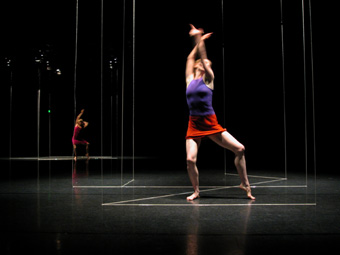The fine lines of creation
Erin Brannigan: Sue Healey, Fine Line Terrain

Sue Healey, Fine Line Terrain, 2003
photo Alejandro Rolandi and Kate Callas
Sue Healey, Fine Line Terrain, 2003
Choreographer Sue Healey is a survivor in the Australian dance scene. Beginning her career with Dance Works (1983-88), Healey led the Canberra-based company Vis-à-Vis from 1993-95. Since then she has choreographed independently, creating works for a fluid company of dancers which has included Michelle Heaven, Philip Adams, Jennifer Newman-Preston, Shona Erskine and Nalina Wait. She has been commissioned by many Australian dance companies and has an ongoing relationship with the Aichi Arts Centre in Japan. Healey has worked with filmmaker Louise Curham (RT58, p15) on several film and installation projects since 1997 and has recently begun directing her own films, including the award-winning Niche (2002) and Fine Line (2003).
Healey is currently a Research Associate with the Unspoken Knowledges Research project, led by Professor Shirley McKechnie at the Victorian College of the Arts. Her recent Niche series has been part of McKechnie’s project and consists of 5 works created between 2002 and 2004: the films mentioned above, 2 live works (Niche/Japan and Fine Line Terrain) and an installation (Niche/Salon). Healey’s finely crafted, intricate choreographies are too rarely presented in Sydney and her upcoming season of Fine Line Terrain at The Studio (Sydney Opera House) has been much anticipated since a showing of the work last year. Since then, the piece has been performed in Auckland, Canberra, Melbourne and New York.
Healey talked to RealTime about the logic behind the Niche series, her interest in space and perception and the challenges she faces as an independent choreographer working with an increasingly consistent company of dancers.
The Niche series covers 5 works and has traversed a number of formats: film, video, installation and performance. Why a series and how is the variety of formats tied to your exploration?
Each work ‘found’ its own niche, so to speak. I started with a dance video focus—wanting to make dance for that specific space rather than my usual method of choreographing the action before its translation into video or film. As our focus was space, it made absolute sense to keep finding new spaces and contexts to explore, manipulate and extend our material, including the screen space, a traditional proscenium space, a white gallery, a new cultural context (Japan) and a ‘site specific’ (30 metre deep) space. I didn’t set out to create a series—it evolved quite organically. I can look back and see that the driving force was a search to place the ‘right’ work in the ‘right’ space.
You are particularly interested in movement and perception. How does this relate to your use of both live and screen formats?
I am not interested in dance as fashion or in movement that disengages perception. I believe that art can make a difference to the way we live our lives. (Experiencing) dance, whether as observer or performer, can enhance the way we perceive our reality as moving, sentient beings interacting on this fragile planet. Perhaps it is even vital. I explore this in both live and screen formats. My current choreographic research is devoted to the manipulation of time and space that video and film makes possible and which offers me a range of new devices only dreamt of when creating live performance. However, I think I will always need to have the visceral, the physical, the real, underpinning the work I create—to keep in touch with the tangible physical drama that occurs as you choreograph. This is because I highly value the memories of performing that I have in my own body.
You have a very strong group of dancers working with you now. How important is it for you to work in this way and what is the real economic viability of such relationships?
The dancers I work with are simply extraordinary. To say that they are fundamental to my process is an understatement. It is a top priority for me to maintain the relationships I have with my dancers. Sustaining employment opportunities for these dancers is the toughest aspect. I can only employ them for short periods scattered throughout the year—I can’t offer them any financial security. What I can offer is a creative framework that has an ongoing sense of development and support. This has been a successful model for us over the last couple of years. For example, Shona Erskine worked on every stage of the Niche series through an initial mentorship grant from the Australia Council. This sense of an ongoing partnership is unusual and difficult to achieve outside of a company scenario.
The difficulty lies in timing grant applications and negotiating around dancers’ other contracts, juggling dates, venues, budgets, schedules, in the hope that providence will bring everything together. Strangely enough it mostly seems to work out. At times I do wonder, however, about the work I could be making if things were different. I do have an occasional lusting for a company model that provides ongoing administrative and production support. Having had that previously, I do think that I have found a unique structure to create within. The success of the Niche series bears witness to this so I think I am on the right path.
–
Fine Line Terrain, choreographer Sue Healey; dancers Victor Bramich, Shona Erskine, Lisa Griffiths, Nelson Reguera Perez, Nalina Wait; lighting Joseph Mercurio, composer Darrin Verhagen; The Studio, Sydney Opera House, June 29-July 3
RealTime issue #61 June-July 2004 pg. 48






